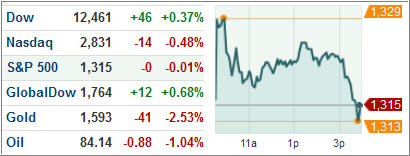Equity ETFs pared early gains to end mixed Thursday after Fed Chairman Ben Bernanke chose to remain silent, despite market expectations of quantitative easing measures and the Chinese central bank cutting interest rates by a quarter percent to ward off a deepening slowdown.
Treasuries remained choppy with the 10-year closing at the highest level in a week after Bernanke said the Fed remains ready to intervene to avoid further slowdown of the economy, but refused to mention monetary stimulus plans.
The Dow Jones Industrial Average (DJIA) gained 0.4 percent despite rising 140 points earlier in the day. The breadth remained positive with 16 of the 30 components in the blue-chip index closing in the green. The Dow is up 2.8 percent over last week, helped by Wednesday’s 287 points jump.
Despite spending most of the day in the green territory following earlier reports that the People’s Bank of China has cut key rates by 25 basis points to stimulate growth, the S&P 500 Index (SPX) closed shop fractionally lower, snapping its three day-long winning streak while the NASDAQ Composite Index (COMP) also ended its three-day long winning run, sliding 0.5 percent.
Treasuries pared earlier losses as risk appetite diminished in the absence of stimulus announcements. The yield on the benchmark 10-year Treasury dropped two basis points to 1.63 percent in late afternoon trade New York time. Yield on 30-year notes remained unchanged though trading remained volatile through the day.
ETFs in the news:
China’s surprise 0.25 percent deposit and lending rate-cut boosted agricultural commodities. Cotton emerged as one of the biggest gainers of the day. Since March 2013, cotton prices have slumped 61 percent due to oversupply. With falling acreages, production has fallen sharply. An improvement in global economy may see cotton demand picking up, pushing prices north. Cotton could enter a bull market in the beginning of 2013 on strong Asian demand.
The Barclays iPath Dow Jones-UBS Cotton Total Return Sub-Index ETN (BAL) came out on top, surging 6.48 percent for the day. BAL can be an interesting ETF in the agricultural commodities segment, should this fund be able to reverse momentum and move back above its long-term trend line. As we head towards the second half of the year, expected strong demand from emerging markets may support this cause.
The latest inventory report from the Energy Information Administration showed US natural gas reserves increased by 62 billion cubic feet last week, faster than analysts’ expectations of 58 billion cubic feet. As a result, the United States Natural Gas Fund (UNG) tumbled 6.12 percent as July future contracts dropped 6.1 percent.
There were no major changes to our Trend Tracking Indexes (TTIs), which will be updated in the latest StatSheet and posted later tonight.
Disclosure: No holdings
Contact Ulli
